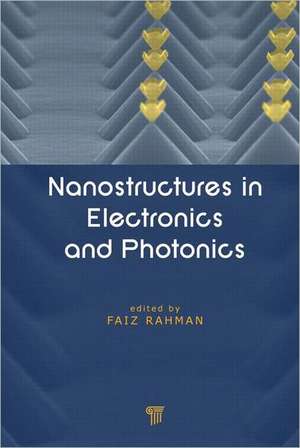Nanostructures in Electronics and Photonics
Autor Faiz Rahmanen Limba Engleză Paperback – 30 apr 2008
The book covers nanoscale materials and devices for both electronics and optical technologies. The emphasis throughout is on experimental methods rather than theoretical modeling. The material will provide food for thought for researchers and research students keen to develop new technologies at the ultra-small scale and to open up new avenues for research.
Preț: 795.29 lei
Preț vechi: 1067.04 lei
-25% Nou
Puncte Express: 1193
Preț estimativ în valută:
152.20€ • 165.26$ • 127.85£
152.20€ • 165.26$ • 127.85£
Comandă specială
Livrare economică 01-15 aprilie
Doresc să fiu notificat când acest titlu va fi disponibil:
Se trimite...
Preluare comenzi: 021 569.72.76
Specificații
ISBN-13: 9789814241106
ISBN-10: 9814241105
Pagini: 316
Ilustrații: 46 b/w images and 79 color images
Dimensiuni: 152 x 229 x 18 mm
Greutate: 0.64 kg
Ediția:1
Editura: Jenny Stanford Publishing
Colecția Jenny Stanford Publishing
ISBN-10: 9814241105
Pagini: 316
Ilustrații: 46 b/w images and 79 color images
Dimensiuni: 152 x 229 x 18 mm
Greutate: 0.64 kg
Ediția:1
Editura: Jenny Stanford Publishing
Colecția Jenny Stanford Publishing
Public țintă
Academic and PostgraduateRecenzii
"The book Nanostructures in Electronics and Photonics, edited by Faiz Rahman, focuses on nanostructures and nanomaterials in the areas of electronics and photonics, two of the most promising and important fields. The book covers a variety of exemplar nanostructures, including nanoparticles, shaped nanoparticles (nanopyramids, nanobelts), nanowires, nanotubes, thin films, and ordered 2D and 3D structures. The structures discussed are composed of metals (especially gold), metal oxides (e.g., ZnO), polymers, and carbon nanotubes … Overall, this is a book that focuses on nanoelectronics and nanophotonics, which is good for novice researchers who can quickly grasp the related information in various research fields. It is also a good reference book for students to use in graduate-level courses on nanoelectronics or nanophotonics, or survey courses on nanotechnology."
—Prof. Zhiyong Gu, Journal of Nanophotonics
"I am very impressed with the presentation of information in this book. The information contained is on the edge of current technology in which there are not many books available yet. I find the pictures informative and of high quality. The text is very well written and it actually reads like a novel. There are valuable explanations on how the work was done — that can be helpful for researchers who wish to start in this field. This is a book I will recommend to my students who are taking my advanced electronics device course. It will make very interesting background reading. Finally this is a reference work I can use. I recommend this book to the general public, anyone with an interest on developments in the field of nanotechnology, especially those who are keen to become involved in this field."
—Dr. Kristel Fobelets, Imperial College London, UK
—Prof. Zhiyong Gu, Journal of Nanophotonics
"I am very impressed with the presentation of information in this book. The information contained is on the edge of current technology in which there are not many books available yet. I find the pictures informative and of high quality. The text is very well written and it actually reads like a novel. There are valuable explanations on how the work was done — that can be helpful for researchers who wish to start in this field. This is a book I will recommend to my students who are taking my advanced electronics device course. It will make very interesting background reading. Finally this is a reference work I can use. I recommend this book to the general public, anyone with an interest on developments in the field of nanotechnology, especially those who are keen to become involved in this field."
—Dr. Kristel Fobelets, Imperial College London, UK
Cuprins
Preface, List of Contributions, 1 From Microstructures to Nanostructures Faiz Rahman, Nanoscale Materials and Structures for Electronics, Nanoscale Materials and Structures for Photonics, Index
Descriere
This book provides a broad overview of nanotechnology as applied to contemporary electronics and photonics. Clearly structured and readable, it covers nanoscale materials and devices for both electronics and optical technologies. The emphasis throughout is on experimental methods rather than theoretical modeling. The material will provide food for thought for researchers and research students keen to develop new technologies at the ultra-small scale and to open up new avenues for research.
